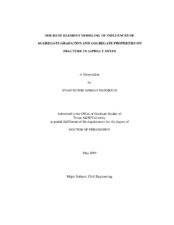| dc.contributor.advisor | Masad, Eyad | |
| dc.creator | Mahmoud, Enad Muhib Ahmad | |
| dc.date.accessioned | 2010-07-15T00:12:50Z | |
| dc.date.accessioned | 2010-07-23T21:44:14Z | |
| dc.date.available | 2010-07-15T00:12:50Z | |
| dc.date.available | 2010-07-23T21:44:14Z | |
| dc.date.created | 2009-05 | |
| dc.date.issued | 2010-07-14 | |
| dc.date.submitted | May 2009 | |
| dc.identifier.uri | https://hdl.handle.net/1969.1/ETD-TAMU-2009-05-586 | |
| dc.description.abstract | Aggregate strength, gradation, and shape play a vital role in controlling asphalt mixture performance. Many studies have demonstrated the effects of these factors on asphalt mixture performance in terms of resistance to fatigue cracking and rutting. This study introduces numerical and analytical approaches supported with imaging techniques for studying the interrelated effects of aggregate strength, gradation, and shape on resistance of asphalt mixtures to fracture. The numerical approach relies on the discrete element method (DEM). The main advantage of this approach is the ability to account for the interaction between the internal structure distribution and aggregate properties in the analysis of asphalt mixture response and performance. The analytical approach combines aggregate strength variability and internal force distribution in an asphalt mixture to predict the probability of aggregate fracture. The numerical and analytical approaches were calibrated and verified using laboratory tests on various aggregate types and mixtures. Consequently these approaches were used to: (1) determine the resistance of various mixture types with different aggregate properties to fracture, (2) study the effects of aggregate strength variability on fracture, (3) quantify the influence of blending different types of aggregate on mixture strength, (4) develop a mathematical expression for calculating the probability of aggregate fracture within asphalt mixture, and (5) relate cracking patterns (cohesive: aggregate - aggregate and matrix - matrix, and adhesive: aggregate - matrix) in an asphalt mixture to internal structure distribution and aggregate properties. The results of this dissertation established numerical and analytical techniques that are useful for developing a virtual testing environment of asphalt mixtures. Such a virtual testing environment would be capable of relating the microscopic response of asphalt mixtures to the properties of the mixture constituents and internal structure distribution. The virtual testing environment would be an inexpensive mean to evaluate the influence of changing different material and design factors on the mixture response. | en |
| dc.format.mimetype | application/pdf | |
| dc.language.iso | eng | |
| dc.subject | Asphalt Mixes, Discrete Element Method, Aggregates, Fracture, Probability, Crack Pattern | en |
| dc.title | Discrete Element Modeling of Influences of Aggregate Gradation and Aggregate Properties on Fracture in Asphalt Mixes | en |
| dc.type | Book | en |
| dc.type | Thesis | en |
| thesis.degree.department | Civil Engineering | en |
| thesis.degree.discipline | Civil Engineering | en |
| thesis.degree.grantor | Texas A&M University | en |
| thesis.degree.name | Doctor of Philosophy | en |
| thesis.degree.level | Doctoral | en |
| dc.contributor.committeeMember | Lytton, Robert | |
| dc.contributor.committeeMember | Epps Martin, Amy | |
| dc.contributor.committeeMember | Herbert, Bruce | |
| dc.type.genre | Electronic Dissertation | en |
| dc.type.material | text | en |


